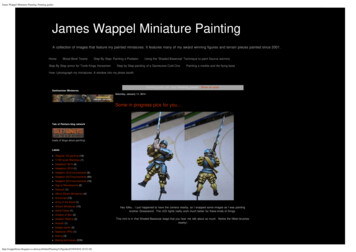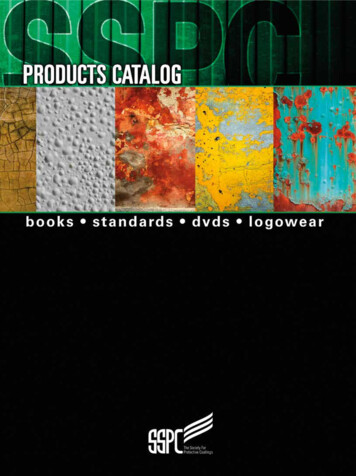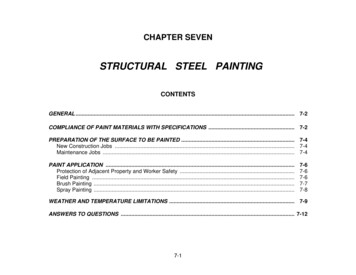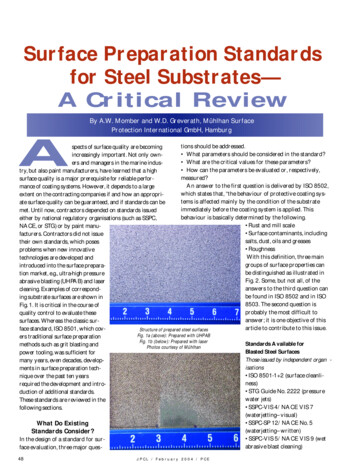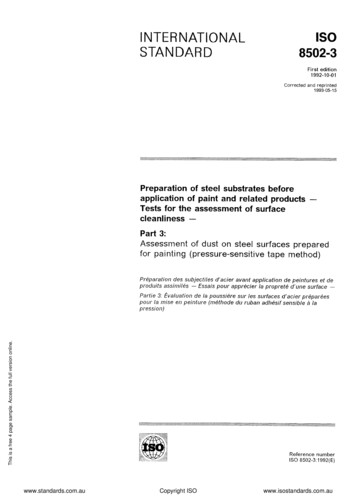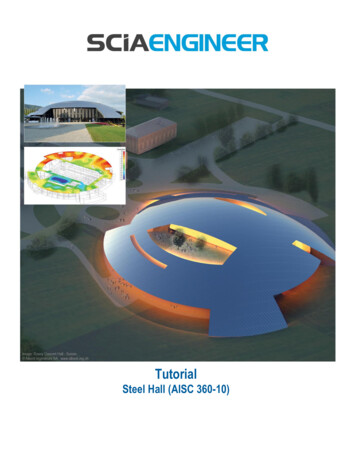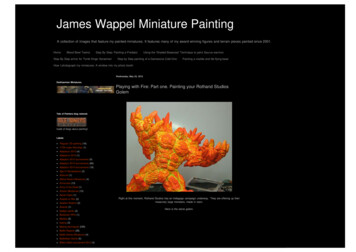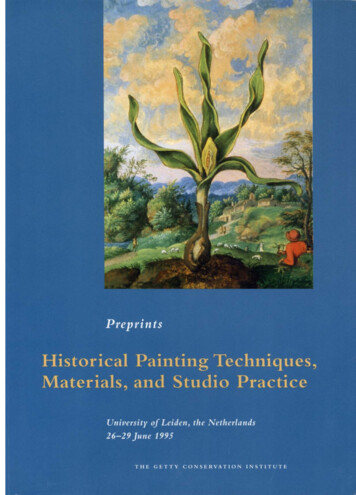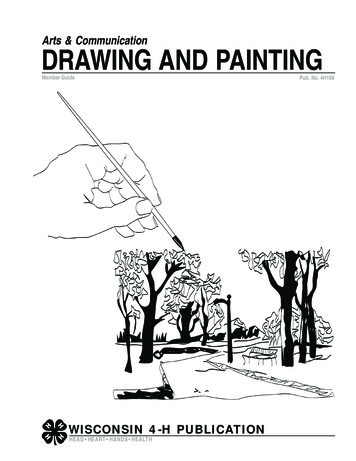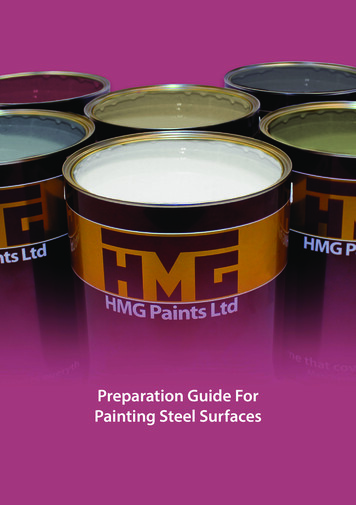
Transcription
Preparation Guide ForPainting Steel Surfaces
ContentsContents 3Foreword 4Scope 5Rust grades 6Preparation grades. Scraping and wire-brushing6Preparation grades. Blast cleaning 7Illustrations of standards 8- 19Steel Surface Preparation and Product Application20SSPC Preparation Descriptions 22Printed by HMG Paints Ltd, Manchester3HMG Paints Ltd,Riverside Works, Collyhurst Road, Manchester, M40 7RUTel: 0161 205 7631 Email: sales@hmgpaint.com Web: www.hmgpaint.com
ForewordScopeThe effective life of a coating of anti-corrosive paint applied to a steel surface is to avery large extent dependent on how thoroughly the surface has been prepared prior topainting. It is also important to be able to specify clearly the quality of preparation requiredin each particular case.This standard refers to surfaces of hot-rolled steel in four different rust grades (A, B, C andD) the same surfaces prepared to two grades of surface quality (St 2 and St 3) by manualscraping and wire-brushing - machine brushing - grinding -etc.The same surfaces prepared to four grades of surface quality (Sa 1, Sa 2, Sa 2½ and Sa 3) byblasting with various abrasives.Accordingly a Standard has been approved, specifying four grades of rusting and a numberof preparation grades, each establishing a quality grade or preparation prior to protectivepainting required on a steel surface in a standard rust grade. These grades are presentedin this Standard as a series of prints, which provide a clearer and more rapidly appreciateddefinition than a verbal description.The standard has been prepared by the Swedish Corrosion Institute in cooperation with theAmerican Society for Testing and Materials, ASTM, and Steel Structures Painting Council,SSPC, USA. In the specifications relating to preparation of surfaces prior to painting, theSSPC and SIS designations correspond as follows:SSPC-Vis 1SIS 05 59 00SSPC-SP5A Sa 3, B Sa 3, C Sa 3 and D Sa 3SSPC-SP10A Sa 2½, B Sa 2½, C Sa 2½ and D Sa 2½SSPC-SP6B Sa2, C Sa 2 and D Sa 2SSPC-SP7B Sa1, C Sa 1 and D Sa 1Examples: A steel originally corresponding to rust grade B, which has been scraped orbrushed to preparation grade 2 is designated B St 2.A steel surface originally corresponding to rust grade B, which has been prepared by blastcleaning to preparation grade 2½ is designated B Sa 2½.The standardized rust and preparation grades are defined by colour prints representing fullscale view of a part of a surface.Descriptions of the SSPC standards can be found on Page 22.4HMG Paints Ltd,Riverside Works, Collyhurst Road, Manchester, M40 7RUTel: 0161 205 7631 Email: sales@hmgpaint.com Web: www.hmgpaint.com5HMG Paints Ltd,Riverside Works, Collyhurst Road, Manchester, M40 7RUTel: 0161 205 7631 Email: sales@hmgpaint.com Web: www.hmgpaint.com
Rust gradesPreparation grades. Blast cleaningASteel surface covered completely with adherent mill scale and with little if any rust.It is assumed that prior to treatment the steel surface has been cleaned of dirt and grease,and that the heavier layers of rust have been removed by chipping.BSteel surface which has begun to rust and from which the mill scale has begun toflake.Sa 1Light blast cleaning. Loose mill scale, rust and foreign matter shell be removed. Theappearance shall correspond to the prints designated Sa 1.CSteel surface on which the mill scale has rusted away or from which it can be scraped, butwith little pitting visible to the naked eye.Sa 2Thorough blast cleaning. Almost all mill scale, rust and foreign matter shall be removed.Finally, the surface is cleaned with a vacuum cleaner, clean dry compressed air or a cleanbrush. It shall be greyish in colour and correspond in appearance to the prints designatedSa 2.DSteel surface on which the mill scale has rusted away and on which considerablepitting is visible to the naked eye.Preparation grades. Scraping and wire-brushingIt is assumed that prior to treatment the steel surface has been cleaned of dirt and grease,and that the heavier layers of rust have been removed by chipping.St 2Thorough scraping and wire-brushing - machine brushing - grinding - etc. The treatmentshall remove loose mill scale, rust and foreign matter. Finally, the surface is cleaned witha vacuum cleaner, clean dry compressed air or a clean brush. It should the have a faintmetallic sheen. The appearance shall correspond to the prints designated St 2.Sa 2½Very thorough blast cleaning. Mill scale, rust and foreign matter shall be removed to theextent that the only traces remaining are slight stains in the forms of spots or stripes.Finally, the surface is cleaned with a vacuum cleaner, clean dry compressed air or a cleanbrush. It shall the correspond in appearance to the prints designated Sa 2½.Sa 3Blast cleaning to pure metal. Mill scale, rust and foreign matter shall be removedcompletely. Finally, the surface is cleaned with a vacuum cleaner, clean dry compressed airor a clean brush. It shall then have a uniform metallic colour and correspond in appearanceto the prints designated in Sa 3.St 3Very thorough scraping and wire-brushing - machine brushing - grinding - etc. Surfacepreparation as for St 2, but much more thoroughly. After removal of dust, the surface shallhave a pronounced metallic sheen and correspond to the prints designated St 3.6HMG Paints Ltd,Riverside Works, Collyhurst Road, Manchester, M40 7RUTel: 0161 205 7631 Email: sales@hmgpaint.com Web: www.hmgpaint.com7HMG Paints Ltd,Riverside Works, Collyhurst Road, Manchester, M40 7RUTel: 0161 205 7631 Email: sales@hmgpaint.com Web: www.hmgpaint.com
Rust GradeARust GradeCRust GradeBRust GradeD8HMG Paints Ltd,Riverside Works, Collyhurst Road, Manchester, M40 7RUTel: 0161 205 7631 Email: sales@hmgpaint.com Web: www.hmgpaint.com9HMG Paints Ltd,Riverside Works, Collyhurst Road, Manchester, M40 7RUTel: 0161 205 7631 Email: sales@hmgpaint.com Web: www.hmgpaint.com
Preparation Grades.Scraping andwire-brushingB St 2Preparation Grades.Scraping andwire-brushingC St 2Preparation Grades.Scraping andwire-brushingB St 3Preparation Grades.Scraping andwire-brushingC St 310HMG Paints Ltd,Riverside Works, Collyhurst Road, Manchester, M40 7RUTel: 0161 205 7631 Email: sales@hmgpaint.com Web: www.hmgpaint.com11HMG Paints Ltd,Riverside Works, Collyhurst Road, Manchester, M40 7RUTel: 0161 205 7631 Email: sales@hmgpaint.com Web: www.hmgpaint.com
Preparation Grades.Scraping andwire-brushingD St 2Preparation grades.Blast cleaningA Sa 2½Preparation Grades.Scraping andwire-brushingD St 3Preparation grades.Blast cleaningA Sa 312HMG Paints Ltd,Riverside Works, Collyhurst Road, Manchester, M40 7RUTel: 0161 205 7631 Email: sales@hmgpaint.com Web: www.hmgpaint.com13HMG Paints Ltd,Riverside Works, Collyhurst Road, Manchester, M40 7RUTel: 0161 205 7631 Email: sales@hmgpaint.com Web: www.hmgpaint.com
Preparation grades.Blast cleaningB Sa 1Preparation grades.Blast cleaningB Sa 2½Preparation grades.Blast cleaningB Sa 2Preparation grades.Blast cleaningB Sa 314HMG Paints Ltd,Riverside Works, Collyhurst Road, Manchester, M40 7RUTel: 0161 205 7631 Email: sales@hmgpaint.com Web: www.hmgpaint.com15HMG Paints Ltd,Riverside Works, Collyhurst Road, Manchester, M40 7RUTel: 0161 205 7631 Email: sales@hmgpaint.com Web: www.hmgpaint.com
Preparation grades.Blast cleaningC Sa 1Preparation grades.Blast cleaningC Sa 2½Preparation grades.Blast cleaningC Sa 2Preparation grades.Blast cleaningC Sa 316HMG Paints Ltd,Riverside Works, Collyhurst Road, Manchester, M40 7RUTel: 0161 205 7631 Email: sales@hmgpaint.com Web: www.hmgpaint.com17HMG Paints Ltd,Riverside Works, Collyhurst Road, Manchester, M40 7RUTel: 0161 205 7631 Email: sales@hmgpaint.com Web: www.hmgpaint.com
Preparation grades.Blast cleaningD Sa 1Preparation grades.Blast cleaningD Sa 2½Preparation grades.Blast cleaningD Sa 2Preparation grades.Blast cleaningD Sa 318HMG Paints Ltd,Riverside Works, Collyhurst Road, Manchester, M40 7RUTel: 0161 205 7631 Email: sales@hmgpaint.com Web: www.hmgpaint.com19HMG Paints Ltd,Riverside Works, Collyhurst Road, Manchester, M40 7RUTel: 0161 205 7631 Email: sales@hmgpaint.com Web: www.hmgpaint.com
Steel Surface Preparation and Product ApplicationRe-PreparationAdvantages Of Blast CleaningIf a surface coating is damaged during the manufacturing process, in transit or when beinghandled, it will be necessary to repair the damaged area. If it is at all possible, the originalsurface treatments should be used in the repair process, to the original specification.The preparation of steelwork obviously has a bearing on the success or failure of anysurface coating, and therefore the following information is relevant to steelwork preparedto Swedish Standard SIS 05 59 00 – Sa 2.5.Surface coatings that are damaged which are being rectified in shop must be blast cleanedto original standard. Particular attention should be paid to weld areas where spatter, slag,etc and heat damaged coatings should be removed. All areas to be treated should becleaned of all contamination including oil, grease dirt and other foreign matter. Subsequentblast cleaning should overlap existing sound coatings.It has been indicated by The British Iron & Steel Research Association that surface coatingapplied to blast cleaned substrates may be expected to last five times as long as the samesurface that had been weathered, then manually wire brushed.British Standard BS 7079: Part A1: 1989 (ISO 8501 – 1:1988) – Surface Finish of Blast CleanedSteel for Painting and Steel Structures Painting Council of America also set out standards forcleanliness.Amplitude – Surface ProfileAmplitude is a measurement (given in microns), that shows the difference betweenthe peaks and troughs in a metal surface produced by blast cleaning. There must beadequate amplitude on the surface of the substrate to ensure good adhesion. However,if the amplitude on the surface is too rough, then there is a risk that the peaks of the blastcleaning process will protrude through the paint film, leading to significantly higher paintconsumption or ‘peak rashing’ or spot rusting.Shop ApplicationsSite ApplicationPrior to the use of any site applied products, all shop applied coatings must be examinedfor cleanliness and damage. Damage must be repaired to in-shop specifications and allareas must be thoroughly cleaned before further coatings are applied. Particular attentionmust be made to ensure that any soluble salt contamination is completely removed.On average, a surface that has been grit blasted should have a profile that lies between50 to 70 microns, and shot blasted steel under blast primers should be 30 to 50 microns.Profiles in excess of 100 microns should be avoided.DegreasingAny surface that is to be blast cleaned and subsequently painted must be thoroughlydegreased and cleaned before hand. This should be done using products in the HMG PrepClean Range.Degreasers must be used in conjunction with an absorbent cloth which must be changedfrequently to avoid re-depositing oil / grease onto the substrate.When degreasing, it is necessary to wear adequate personal protection equipment. Referto Material Safety Datasheets for further information.20HMG Paints Ltd,Riverside Works, Collyhurst Road, Manchester, M40 7RUTel: 0161 205 7631 Email: sales@hmgpaint.com Web: www.hmgpaint.com21HMG Paints Ltd,Riverside Works, Collyhurst Road, Manchester, M40 7RUTel: 0161 205 7631 Email: sales@hmgpaint.com Web: www.hmgpaint.com
SSPC Preparation DescriptionsSSPC Preparation DescriptionsSSPC-SP5SSPC-SP7A White Metal Blast Cleaned surface, when viewed without magnification, shall be free of allvisible oil, grease, dirt,dust, mill scale, rust, paint, oxides, corrosion products, and other foreign matter. Beforeblast cleaning, visible depositsof oil or grease shall be removed by any of the methods specified in SSPC-SP1 or otheragreed upon methods. Forcomplete instructions, refer to Joint Surface Preparation Standard SSPC-Sp5/NACE No.1.A Brush –Off Blast Cleaned surface, when viewed without magnification, shall be free of allvisible oil, grease, dirt, dust, loose mill scale, loose rust, and loose paint. Tightly adherentmill scale, rust, and paint may remain on the surface.Mill scale, rust, and coating are considered adherent if they cannot be removed by liftingwith a dull putty knife. Before blast cleaning, visible deposits of oil or grease shall beremoved by any of the methods specified in SSPC-SP1 or other agreed upon methods. Forcomplete instructions, refer to Joint Surface Preparation Standard SSPC-SP7/ NACE No.4.SSPC-SP10A Near-White Blast Cleaned surface, when viewed without magnification, shall be free ofall visible oil, grease, dirt, dust, mill scale, rust, paint, oxides, corrosion products, and otherforeign matter, except for staining. Staining shall be limited to no more than five percent ofeach square-inch of surface area and may consist of light shadows, slight steaks, or minordiscolouration caused by stains of rust, stains of mill scale, or stains of previously appliedpaint. Before blast cleaning, visible deposits of oil or grease shall be removed by any of themethods specified in SSPC-SP1 or other agreed upon methods. For complete instructions,refer to Joint Surface Preparation Standard SSPC-SP10/NACE No.2.SSPC-SP6A Commercial Blast Cleaned surface, when viewed without magnification, shall be free ofall visible oil, grease, dirt, dust, mill scale, rust, paint, oxides, corrosion products, and otherforeign matter, except for staining. Staining shall be limited to no more than 33 percent ofeach square –inch of surface area and may consist of light shadows , slight streaks, or minordiscolouration caused by stains of rust, stains of mill scale, or stains of previously appliedpaint. Before blast cleaning, visible deposits of oil or grease shall be removed by any of themethods specified in SSPC-SP1 or other agreed upon methods. For complete instructions,refer to Joint Surface Preparation Standard SSPC-SP6/
SSPC-Vis 1 SIS 05 59 00 SSPC-SP5 A Sa 3, B Sa 3, C Sa 3 and D Sa 3 SSPC-SP10 A Sa 2½, B Sa 2½, C Sa 2½ and D Sa 2½ SSPC-SP6 B Sa2, C Sa 2 and D Sa 2 SSPC-SP7 B Sa1, C Sa 1 and D Sa 1 Descriptions of the SSPC standards can be found on Page 22. Scope This standard refers to surfaces of hot-rolled steel in four different rust grades (A, B, C and D) the same surfaces prepared to two grades
